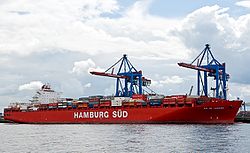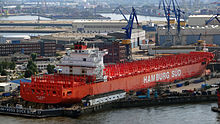Rio class
|
Rio de Janeiro at Burchardkai in Hamburg
|
||||||||||||||
|
||||||||||||||
|
||||||||||||||
|
||||||||||||||
|
||||||||||||||
|
||||||||||||||
The Rio class is a six container ships of Postpanmax class comprehensive ship class of the German shipping company Hamburg Süd . The ships were put into service in 2008 and 2009 and, with a total length of 286.45 meters and a total container capacity of 5905 TEU, have been the shipping company's second largest container ships since the ships of the Santa class were commissioned . The ships operate liner services between Northern Europe and the east coast of South America .
Technical specifications
The Rio class is classified by Germanischer Lloyd . The hull has the classification + 100 A5 E with Freeboard 5.974 M Container Ship IW BWM SOLAS-II-2 Reg. 19, the machine system + MC E AUT RCP 1085/25.
The ships have a total length of 286.45 meters, a width of 40.00 meters and with a carrying capacity of 80,455 tons, a draft of 13.50 meters. This makes them a 40-foot container loading space longer than the Monte class from the same shipping company. The number of container spaces is 5905 TEU (20-foot container). Connections are available for 1365 refrigerated containers. The loading capacity for loaded, 14-tonne 20-foot containers is given as 4,380 TEU. The gross tonnage (GT) is 73,899, the net tonnage (NRZ) 31,228.
Are driven vessels of a marine diesel engine of the type Wärtsilä -Sulzer 8RTA96C-B with eight cylinders and a power of 45,760 kW. The two - stroke crosshead engine drives a ship's propeller . The “Rio” class reaches a speed of 23.0 knots . The ships were equipped with a bow thruster (2000 kW) and a stern thruster (1500 kW).
The electric power is supplied by four of auxiliary diesel driven generators (3 x 5,860 kVA, 1 × 3,857 kVA) in the voltage of 6,600 volts.
Ships
Three ships of the Rio class were put into service in 2008, three more in 2009. The names of the container ships all begin with “Rio”, from which the name of the ship class is derived. The construction contract for the first three ships into service was placed on June 1, 2005, and they were built at the shipyard of Daewoo Shipbuilding & Marine Engineering ; Co., Ltd. (HHI) in Okpo , South Korea . The three ships put into service in 2009 were built in Mangalia , Romania , at Daewoo Mangalia Heavy Industries (DMHI).
The ships each belong to the one-ship companies belonging to the Hamburg-Süd Group. The Columbus Shipmanagement Gesellschaft (CSG), which is also part of the Hamburg Süd Group, is responsible for ship management for four of the Rio class. The first two ships of the class are from Hamburg Süd even bereedert .
All ships of the class came under the German flag with home port Hamburg. Several of the ships are now sailing under the Liberian flag with their home port of Monrovia.
Rio de la Plata
The Rio de la Plata ( IMO number 9357951) is the lead ship of the ship class. The keel was laid under hull number DSME 4122 on November 12, 2007, the float on January 26, 2008. The ship was christened on March 17, 2008 and named after the Río de la Plata . The Río de la Plata is the joint mouth of the major South American rivers Paraná and Uruguay , where the important ports of Buenos Aires and Montevideo are located. The ship was delivered on April 2, 2008 and was initially used for a short time in the Asia – South America East Coast Service before being threaded into the Europe – South America East Coast Service. The ship initially sailed under the German flag. From 2012 the Rio de la Plata sailed under the Liberian flag. The ship has been flying the Singapore flag since 2018 .
Rio de Janeiro
The Rio de Janeiro (IMO number 9357963) was the second new build in the Rio class. The keel of the ship under construction number DSME 4123 took place on February 4, 2008, it was floated on April 19, 2008 and christened on June 10, 2008. After delivery on June 12, 2008, the ship initially sailed until autumn 2008 in the Asia-South America-East Coast Service. The ship initially sailed under the German flag and has been sailing under the Singapore flag since 2018 .
Rio Negro
The Rio Negro (IMO number 9357975) is named after the tributary of the Amazon of the same name . Construction of the ship under construction number DSME 4124 began on May 1, 2008. The keel was laid on June 16, 2008 and the float on August 30, 2008. The ship was christened on October 30, 2008 at the shipyard in South Korea and delivered to the shipping company on November 4, 2008. It was temporarily used until spring 2009 in the “New Good Hope Express Service” between Asia and South Africa and the South American east coast. The ship initially sailed under the German flag and has been sailing under the Singapore flag since 2018 .
Rio Blanco
The Rio Blanco (distinctive signal DGPT2, IMO number 9348089) is the first ship of the class to be built in Mangalia, Romania. It was manufactured under construction number 4069 and delivered to Hamburg Süd on June 3, 2009. The ship was christened on August 23, 2009 at the Container Terminal Burchardkai in the Port of Hamburg. It is named after the Río Blanco , a river in the Región de Valparaíso in Chile . The ship was used from the beginning in the "River Plate Express Service" liner service between Europe and the east coast of South America. The ship initially sailed under the German flag. From 2012 the Rio Blanco sailed under the Liberian flag. The ship has been flying the Singapore flag since 2018.
Rio Bravo
The Rio Bravo (IMO number 9348091) was built at the Daewoo shipyard in Mangalia under construction number 4070 and delivered on August 18, 2009. After delivery, the ship initially sailed between Asia, South Africa and the east coast of South America before switching to liner service between Europe and the east coast of South America in mid-October 2009. It was christened on November 12, 2009 in the port of Antwerp , which it first called at before. The Rio Bravo is named after the Rio Bravo del Norte , which is the Spanish name of the Rio Grande . The Rio Grande is a stream in the United States and Mexico. The ship initially sailed under the German flag. From 2012 the Rio Bravo sailed under the Liberian flag. From 2018 she sailed under the flag of the Marshall Islands. The ship has been flying the Singapore flag since 2018.
Rio Madeira
The Rio Madeira (IMO number 9348106) is the last ship of the Rio class to be built. It was built at the Daewoo shipyard in Mangalia under construction number 4071 and was delivered to the shipping company there on November 11, 2009. The ship was christened on January 14, 2010 in Montevideo, Uruguay, and named after the Rio Madeira , the largest tributary of the Amazon (and largest tributary in the world). After delivery, the ship initially drove between Asia and the east coast of South America. After the baptism, it was threaded into the regular service between Europe and the South American east coast. The ship initially sailed under the German flag. From 2013 the Rio Madeira sailed under the Liberian flag. The ship has been flying the Singapore flag since 2018.
route
The ships of the Rio class operate in the container liner service "River Plate Express Service" of the shipping company Hamburg Süd between Europe and the east coast of South America and replace the ships of the "Monte" class on this connection . Six ships operate on the line. A round trip takes 42 days. Each port is called once a week. In Northern Europe, the ports of Rotterdam (Netherlands), Tilbury (United Kingdom), Hamburg (Germany), Antwerp (Belgium) and Le Havre (France) are called one after the other . After crossing the Atlantic Ocean , the ports of Santos (Brazil), Buenos Aires (Argentina), Montevideo (Uruguay), Rio Grande (Brazil), Santos again and most recently Itaguaí (Brazil) will be called at in South America (as of 2009).
Web links
supporting documents
Much of the information in this article comes from
- Hamburg Süd (Ed.): Hamburg Süd christened its largest container ship to date with the “Rio de la Plata”. Press release, Hamburg March 17, 2008. Accessed June 21, 2009.
- Hamburg Süd (Ed.): 5,900 TEU container ship "Rio de Janeiro" christened in Korea. Press release, Hamburg June 10, 2008. Accessed June 21, 2009.
- Hamburg Süd (Ed.): “Rio Negro” baptized in Korea. Press release, Hamburg October 30, 2008. Accessed June 21, 2009.
- Hamburg Süd (Ed.): “Rio Blanco” baptized in Hamburg. Press release, Hamburg August 24, 2009. Accessed January 19, 2010.
- Hamburg Süd (Ed.): "Rio Bravo" is baptized today in Antwerp. Press release, Hamburg November 12, 2009. Retrieved January 19, 2010.
- Hamburg Süd (Ed.): "Rio Madeira" baptized in Montevideo. Press release, Hamburg January 15, 2010. Accessed January 19, 2010.
- Hamburg Süd (Ed.): Rio de la Plata , Rio de Janeiro , Rio Negro , Rio Blanco , Rio Bravo , Rio Madeira. In: Services & Offices; Fleet; Ships. Retrieved January 19, 2010.
In addition, the following individual references are cited:
- ↑ a b DNV GL: Rio de La Plata. Retrieved August 19, 2017 .
- ↑ Hamburg Süd (Ed.): Columbus Shipmanagement GmbH. ( Memento of the original from June 29, 2012 in the Internet Archive ) Info: The archive link was inserted automatically and has not yet been checked. Please check the original and archive link according to the instructions and then remove this notice. Retrieved August 16, 2012.
- ↑ Daewoo-Mangalia Heavy Industries (Ed.): 03/06/2009 Delivery Hull No. 4069 "Rio Blanco". In: News 2009 . Retrieved January 19, 2010.
- ↑ Daewoo-Mangalia Heavy Industries (Ed.): 08/18/2009 Delivery Hull No. 4070 "Rio Bravo". In: News 2009 . Retrieved January 19, 2010.
- ↑ Daewoo-Mangalia Heavy Industries (Ed.): 11/11/2009 Delivery Hull No. 4071 "Rio Medeira". In: News 2009 . Retrieved January 19, 2010.
- ↑ Hamburg Süd (Ed.): River Plate Express Service (Engl.). Retrieved June 21, 2009.


